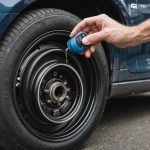Tackling slippery conditions on your Yamaha Super Ténéré requires more than just skill; it demands a nuanced understanding of traction control. This guide unveils essential tips and techniques to master traction control, enhancing your safety and performance on challenging terrains. From exploring the benefits of different riding modes to practical exercises for maximizing grip, this comprehensive resource equips you with the knowledge needed to navigate adverse conditions effectively. Prepare to elevate your riding experience and tackle every twist and turn with confidence.
Understanding Traction Control on the Yamaha Super Ténéré
The traction control system is a critical feature in maintaining motorcycle stability, especially on challenging terrains. For the Yamaha Super Ténéré, this system is designed to enhance the rider's confidence and safety. By preventing the wheels from slipping under acceleration, the traction control ensures that the motorcycle maintains its grip on the road.
Also to see : Maximizing Resale Value: Essential Tips for Your BMW F850GS
How the Yamaha Super Ténéré's Traction Control Works
The Yamaha Super Ténéré features a sophisticated traction control system that monitors wheel speed and throttle position. When it detects a potential loss of traction, it adjusts the engine power output to prevent wheel spin. This process is seamless and allows the rider to focus on the road without worrying about losing control.
Differences Between Various Traction Control Settings
The Yamaha Super Ténéré offers multiple traction control settings to cater to different riding conditions and preferences. Riders can choose from:
Additional reading : Mastering Tire Air Pressure: Tips for Achieving Optimal Stability in Your Piaggio MP3
- Mode 1: Allows for more wheel slip, suitable for off-road adventures where some wheel spin may be beneficial.
- Mode 2: Provides more intervention, ideal for wet or slippery conditions where maximum stability is required.
- Off: Disables the traction control system entirely, giving experienced riders full control over the motorcycle.
These settings allow riders to tailor the motorcycle's performance to their specific needs, enhancing both safety and enjoyment.
Adjusting Traction Control Settings
Understanding how to adjust the traction control settings on your Yamaha Super Ténéré can significantly enhance your motorcycle performance. Customizable options allow you to tailor the ride to your preferences and the current weather conditions.
Step-by-Step Guide to Accessing and Adjusting Settings
To access the traction control settings, locate the control panel on your motorcycle's dashboard. Use the menu button to navigate to the settings menu. Once there, select the traction control option. You will see the available modes: Mode 1, Mode 2, and Off. Use the toggle switch to select your desired setting. Confirm your choice to activate the new setting.
Recommended Settings for Different Weather Conditions
- Dry Conditions: Mode 1 is ideal. It allows some wheel slip, enhancing maneuverability on dry surfaces.
- Wet or Slippery Conditions: Opt for Mode 2. This setting provides maximum stability, reducing the risk of wheel spin.
- Off-Road: Mode 1 can be beneficial, but experienced riders might prefer turning the system off for complete control.
Customization Options for Rider Preferences
The Yamaha Super Ténéré's traction control settings offer flexibility, allowing riders to adapt the motorcycle's performance to their unique style. Whether you're navigating city streets or exploring rugged trails, these settings ensure a safer and more enjoyable ride.
Riding Techniques for Slippery Conditions
Riding a motorcycle in slippery conditions requires a refined approach to ensure safety and control. Understanding the right techniques can make a significant difference in handling your motorcycle effectively.
Key Techniques for Wet or Icy Roads
When navigating wet or icy roads, maintaining control is paramount. One crucial technique is to keep your motorcycle handling smooth and deliberate. Avoid sudden movements or harsh braking that could lead to a loss of traction. Instead, apply gentle pressure to the brakes and throttle to maintain stability.
Body Positioning and Throttle Control for Stability
Your body positioning plays a vital role in maintaining balance. Lean slightly forward to keep the motorcycle's weight centered, which helps in better motorcycle handling. Additionally, throttle control is essential. Gradually increase the throttle to prevent the wheels from spinning out. This approach ensures that you maintain a steady pace without abrupt acceleration.
Importance of Smooth Inputs and Anticipating Traction Loss
Smooth inputs are crucial in slippery conditions. Anticipate potential traction loss by scanning the road ahead for hazards like wet leaves or ice patches. Adjust your speed accordingly and maintain a safe distance from other vehicles. By staying alert and using these techniques, you can navigate challenging conditions with greater confidence and control.
Real-World Scenarios and Application
Understanding how traction control performance translates into real-world riding is crucial for Yamaha Super Ténéré owners. In practical riding scenarios, especially during adverse weather, traction control can make a significant difference.
Case Studies of Traction Control in Action
Consider a rider navigating a rain-soaked highway. With traction control engaged, the system detects wheel slip and adjusts power output, preventing skidding. This real-world application showcases how traction control enhances safety, allowing riders to maintain stability even in challenging conditions.
Analyzing Rider Feedback and Experiences
Feedback from riders highlights the benefits of traction control in slippery conditions. Many riders report increased confidence when facing unexpected weather changes. They appreciate how the system intervenes seamlessly, offering a smoother ride without constant adjustments on their part. Such experiences underscore the practical value of traction control.
Adapting Riding Style Based on Traction Control Performance
Riders can optimize their experience by adapting their riding style to the traction control performance. For instance, in wet conditions, a gentle throttle approach complements the system's interventions, ensuring a balanced ride. By understanding and leveraging traction control, riders can enhance their safety and enjoyment across various terrains.
Safety Tips for Riding with Traction Control
Riding with traction control enhances motorcycle safety, but understanding its limits and employing the right strategies is crucial.
Essential Safety Gear and Precautions
To ensure motorcycle safety in slippery conditions, always wear essential safety gear. This includes a helmet, gloves, boots, and a jacket with protective padding. Each piece of gear offers critical protection against potential falls or accidents. Additionally, ensure your motorcycle is equipped with proper tyres suited for wet or icy roads.
Understanding Limits of Traction Control
While traction control offers significant benefits, it has its limits. In certain situations, such as deep mud or loose gravel, you might need to override the system. Experienced riders can do this by switching to a more suitable mode or turning the system off entirely, allowing for better control in these specific conditions.
Strategies for Safe Riding in Challenging Environments
Employ effective riding tips to navigate challenging environments safely. Maintain a safe distance from other vehicles and avoid sudden movements that could cause a loss of traction. Use smooth and deliberate inputs for braking and accelerating. By staying alert and adapting your riding style, you can maximise the benefits of traction control while ensuring a safe ride.
Troubleshooting Common Traction Control Issues
Understanding how to address traction control problems can ensure a smoother riding experience. For Yamaha Super Ténéré owners, recognising and resolving these issues is vital for maintaining optimal performance.
Identifying Common Traction Control System Issues
Common issues with the traction control system often include unexpected activation, lack of response, or erroneous warning lights. These problems can be caused by sensor malfunctions, wiring issues, or software glitches. Identifying these symptoms early can prevent further complications.
Step-by-Step Troubleshooting Guide for Riders
- Check the Sensors: Ensure that the wheel speed sensors are clean and properly aligned. Dirt or misalignment can lead to inaccurate readings.
- Inspect the Wiring: Look for any visible damage or loose connections in the wiring harness connected to the traction control system.
- Software Reset: Sometimes, a simple reset of the system can resolve minor software issues. Refer to your manual for reset instructions.
When to Seek Professional Help for Traction Control Repairs
If the above steps do not resolve the issue, it is advisable to consult a professional mechanic. Persistent problems, such as continuous warning lights or system failure, require expert attention. Professional maintenance ensures that your traction control system is thoroughly inspected and repaired, restoring your motorcycle’s safety features.
Enhancing Performance with Traction Control
To truly maximise the performance enhancement offered by traction control on your Yamaha Super Ténéré, consider various modifications and upgrades. These can significantly boost the system's effectiveness and your overall riding experience.
Modifications and Upgrades for Enhanced Traction Control
Investing in high-quality tyres specifically designed for your riding conditions can greatly improve traction. Additionally, upgrading your motorcycle's suspension system can enhance stability and handling, allowing the traction control system to perform optimally. Regular maintenance and tuning of your bike also ensure that all components work in harmony, providing a smoother ride.
Advanced Riding Techniques and Training
Enrolling in training courses focused on advanced riding techniques can elevate your skills, enabling you to fully utilise the benefits of traction control. These courses often cover topics such as throttle control, body positioning, and braking techniques, equipping you with the knowledge to handle various terrains confidently.
Joining Riding Communities for Shared Experiences
Engaging with riding communities offers invaluable insights into motorcycle upgrades and advanced techniques. Sharing experiences with fellow riders can provide practical tips and recommendations for enhancing your bike's performance. Additionally, these communities often organise group rides and workshops, offering opportunities to learn and practice new skills in a supportive environment.
Visual Aids and Resources
Understanding the traction control system on your Yamaha Super Ténéré can be enhanced with the right visual guides and educational materials. These resources provide a clearer picture of how the system functions and its benefits.
Recommended Diagrams and Videos
Visual aids, such as detailed diagrams, are invaluable for grasping the mechanics behind traction control. These diagrams typically illustrate the system's components and how they interact to prevent wheel slip. Coupled with videos, these resources offer dynamic explanations that can clarify complex concepts through real-world demonstrations.
Online Resources and Forums for Yamaha Super Ténéré Riders
The internet is a treasure trove of riding resources. Online forums dedicated to Yamaha Super Ténéré riders are excellent platforms for sharing experiences and troubleshooting advice. These communities often provide links to videos, articles, and personal insights that can deepen your understanding of your motorcycle's features.
Summarizing Key Takeaways and Additional Reading Materials
To consolidate your knowledge, consider summarizing key takeaways from these resources. This practice helps reinforce learning and ensures a practical application of the information. Additionally, explore further reading materials, such as technical manuals and expert reviews, to expand your understanding of traction control and its impact on motorcycle performance.

















